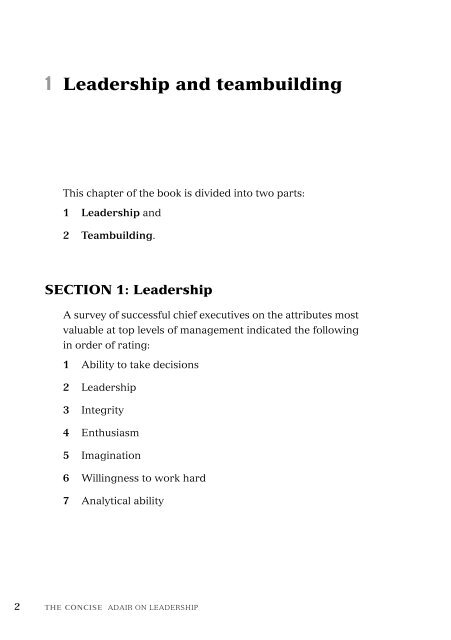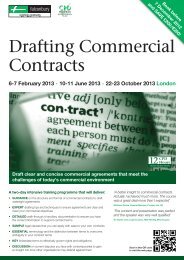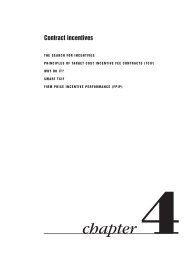Sample chapter - Thorogood Publishing
Sample chapter - Thorogood Publishing
Sample chapter - Thorogood Publishing
Create successful ePaper yourself
Turn your PDF publications into a flip-book with our unique Google optimized e-Paper software.
1 Leadership and teambuildingThis <strong>chapter</strong> of the book is divided into two parts:1 Leadership and2 Teambuilding.SECTION 1: LeadershipA survey of successful chief executives on the attributes mostvaluable at top levels of management indicated the followingin order of rating:1 Ability to take decisions2 Leadership3 Integrity4 Enthusiasm5 Imagination6 Willingness to work hard7 Analytical ability2 THE CONCISE ADAIR ON LEADERSHIP
8 Understanding of others9 Ability to spot opportunities10 Ability to meet unpleasant situations11 Ability to adapt quickly to change12 Willingness to take risks13 Enterprise14 Capacity to speak lucidly15 Astuteness16 Ability to administer efficiently17 Open-mindedness18 Ability to ‘stick to it’19 Willingness to work long hours20. Ambition21 Single-mindedness22 Capacity for lucid writing23 Curiosity24 Skill with numbers25 Capacity for abstract thoughtPART 1 LEADERSHIP AND TEAMBUILDING 3
There is (has and probably always will be) a debate about thedifferences and overlaps of leadership and management.Current opinion is that they are different concepts but theyoverlap considerably.ManagementLeadershipPerhaps management has the overtone of carrying out objectiveslaid down by someone else. It is certainly true that a wellmanagedbusiness, in the sense of having perfect organisation,still needs that extra something.Leadership has five distinctive nuances not found in management.A leader must:1 Give direction2 Provide inspiration3 Build teams4 THE CONCISE ADAIR ON LEADERSHIP
4 Set an example5 Be accepted.Henri Fayol (in 1916) divided the activities of an industrialcompany into six main groups:1 Technical – production, manufacture and adaptation.2 Commercial – buying, selling and exchange.3 Financial – search for and optimum use of capital.4 Security – protection of property and people.5 Accounting – stocktaking, balance sheets, costs andstatistics.6 Administration – forecasting and planning, organising,commanding, co-ordinating and controlling.Good administration is the hallmark of good management andthe proper and efficient use of resources. Managers becomeleaders when their personality and character, their knowledgeand functional skills of leadership are recognised and acceptedby the others involved.PART 1 LEADERSHIP AND TEAMBUILDING 5
Leadership can be ‘specific to the particular situation’ and its‘authority’ can derive from:1 position (as in job title, rank or appointment),2 personality (as in natural qualities of influence) and3 knowledge (as in technical professional skills).Fayol listed these following qualities as being needed by a personin ‘command’. A person in command should:• have a thorough knowledge of employees• eliminate the incompetent• be well versed in the agreements binding the business andits employees• set a good example• conduct periodic audits of the organisation and use summarisedcharts to further this review• bring together the chief assistants by means of conferencesat which unity of direction and focusing of effort areprovided for• not become engrossed in detail• aim at making unity, energy, initiative and loyalty prevailamong all employees.6 THE CONCISE ADAIR ON LEADERSHIP
The seven qualities of leadershipA leader is the kind of person (with leadership qualities) whohas the appropriate knowledge and skill to lead a group toachieve its ends willingly. This section will look at the qualitiesand functions of leadership.Personality and character cannot be left out of leadership. Thereare certain generic leadership traits, the seven important onesare:1 EnthusiasmTry naming a leader without it!2 IntegrityMeaning both personal wholeness and sticking tovalues outside yourself, primarily goodness andtruth – this quality makes people trust a leader.3 ToughnessDemanding, with high standards, resilient, tenaciousand with the aim of being respected (not necessarilypopular).4 FairnessImpartial, rewarding/penalising performancewithout ‘favourites’, treating individuals differentlybut equally.PART 1 LEADERSHIP AND TEAMBUILDING 7
5 Warmththe heart as well as the mind being engaged, lovingwhat is being done and caring for people – coldfish do not make good leaders.6 HumilityThe opposite of arrogance, being a listener andwithout an overwhelming ego.7 ConfidenceNot over-confidence (which leads to arrogance),but with self-confidence which people knowwhether you have or have not got it.In testing whether or not you have the basic qualities of leadership,you should ask yourself these questions.Do I possess the above mentioned sevenqualities? (This ‘test’ will subsequentlyreveal whether or not you really do!)Have I demonstrated that I am aresponsible person?YesNo8 THE CONCISE ADAIR ON LEADERSHIP
Do I like the responsibility and therewards of leadership?Am I well-known for my enthusiasm atwork?Have I ever been described as havingintegrity?Can I show that people think of me asa warm person?Am I an active and socially participativeperson?Do I have the self-confidence to takecriticism, indifference and/or unpopularityfrom others?Can I control my emotions and moodsor do I let them control me?Have I been dishonest or less thanstraight with people who work for meover the past six months?Am I very introvert, very extrovert (oram I an ambivert – mixture of both – asleaders should be)?YesNoPART 1 LEADERSHIP AND TEAMBUILDING 9
If leadership depends on the situation, you need to ask yourself,whatever your qualities, whether you are right for thesituation:Are your interests, aptitudes andtemperament suited to your currentfield of work?If not, can you identify one that wouldbetter suit you where you wouldemerge as a leader?Do you have the ‘authority ofknowledge’ in your current field (andhave you acquired all the necessaryprofessional and specialist skillsthrough training that you could havedone at this point in your career?)Are you experienced in more than onefield/industry/function?Are you interested in fields adjacentand relevant to your own?Do you read situations well and areyou flexible in your approach tochanges within your field?YesNo10 THE CONCISE ADAIR ON LEADERSHIP
Functions of leadershipIn leadership, there are always three elements or variables:1 The leaderQualities of personality and character.2 The situationPartly constant, partly varying.3 The groupThe followers: their needs and values.This section of the book looks at leadership functions in relationto the needs of work groups. These needs can be seen asthree overlapping needs:1 Task needTo achieve the common task.2 Team maintenance needsTo be held together or to maintain themselves as a team.3 Individual needsThe needs which individuals bring with them into the group.PART 1 LEADERSHIP AND TEAMBUILDING 11
These three needs (the task, team and individual) are the watchwordsof leadership and people expect their leaders to:• help them achieve the common task• build the synergy of teamwork and• respond to individuals and meet their needs.The task needs work groups or organisations to come into beingbecause the task needs doing and cannot be done by one personalone. The task has needs because pressure is built up to accomplishit to avoid frustration in the people involved if they areprevented from completing it.The team maintenance needs are present because the creation,promotion and retention of group/organisational cohesivenessis essential on the ‘united we stand, divided we fall’ principle.The individual needs are the physical ones (salary) and thepsychological ones of:• recognition• a sense of doing something worthwhile• status• the deeper need to give and to receive from other peoplein a working situation.12 THE CONCISE ADAIR ON LEADERSHIP
The Task, Team and Individual needs overlap:Task needsTeamneedsIndividualneedsThis overlapping is evident in that:• achieving the task – builds the team and satisfies the individualsinvolved• if team maintenance fails (the team lacks cohesiveness)performance on the task is impaired and individual satisfactionis reduced• if individual needs are not met – the team will lack cohesivenessand performance of the task will be impaired.PART 1 LEADERSHIP AND TEAMBUILDING 13
Leadership exists at different levels:Team leadershipOf teams of about 5 to 20 people.Operational leadershipA significant must in a business or organisation comprisinga number of teams whose leaders report to you.Strategic leadershipA whole business or organisation, with overall accountabilityfor the levels of leadership below you.At whatever level of leadership, Task, Team and Individual needsmust be constantly thought about. To achieve the common task,maintain teamwork and satisfy the individuals, certain functionshave to be performed. A function is what leaders do asopposed to a quality which is an aspect of what they are.These functions (the functional approach to leadership, alsocalled action-centred leadership) are:• Defining the task• Planning• Briefing• Controlling• Evaluating14 THE CONCISE ADAIR ON LEADERSHIP
• Motivating• Organising• Providing an exampleLeadership functions in relation to Task, Team and Individualcan be represented by this diagram:THE ROLEFUNCTIONSBuilding andmaintainingthe TEAMAchieving the TASKDeveloping theINDIVIDUALDefining the taskPlanningBriefingControllingEvaluatingMotivatingOrganisingProviding anexampleLEADERSHIP FUNCTIONSThese leadership functions need to be handled with excellenceand this is achieved by performing those functions with increasingskill. Before examining the skills of leadership, it is worthseeing where certain qualities of leadership can be viewed ashaving functional value. These can be examined as leadershipcharacteristics.PART 1 LEADERSHIP AND TEAMBUILDING 15
Leadership characteristicsThe needTaskTeamQualityInitiativePerseveranceEfficiencyHonestySelf-confidenceIndustryAudacityHumilityIntegrityHumourAudacitySelf-confidenceFunctional valuegets the group movingprevents the group giving upwork done well knowing costs(energy, time and money)establishing factsfacing factssteady application pays dividendswhen not to be restrained byrules or conventionfacing up to mistakes and notblaming othersintegrating the team andcreating trustrelieving tension and maintaininga sense of proportioninspire through originalityor vervetrusted by others16 THE CONCISE ADAIR ON LEADERSHIP
The needTeamcontinuedQualityJusticeHonestyHumilityFunctional valuefair dealing builds groupdisciplinewins respectnot selfish, shares praise, notarrogant and divisiveIndividualTactCompassionConsistencyHumilityHonestyJusticesensitive in dealing with peoplesympathetic awareness and helppeople know where they standrecognises qualities/abilitiesand gives creditwins individual respectfair-dealing encouragesindividualsPART 1 LEADERSHIP AND TEAMBUILDING 17









